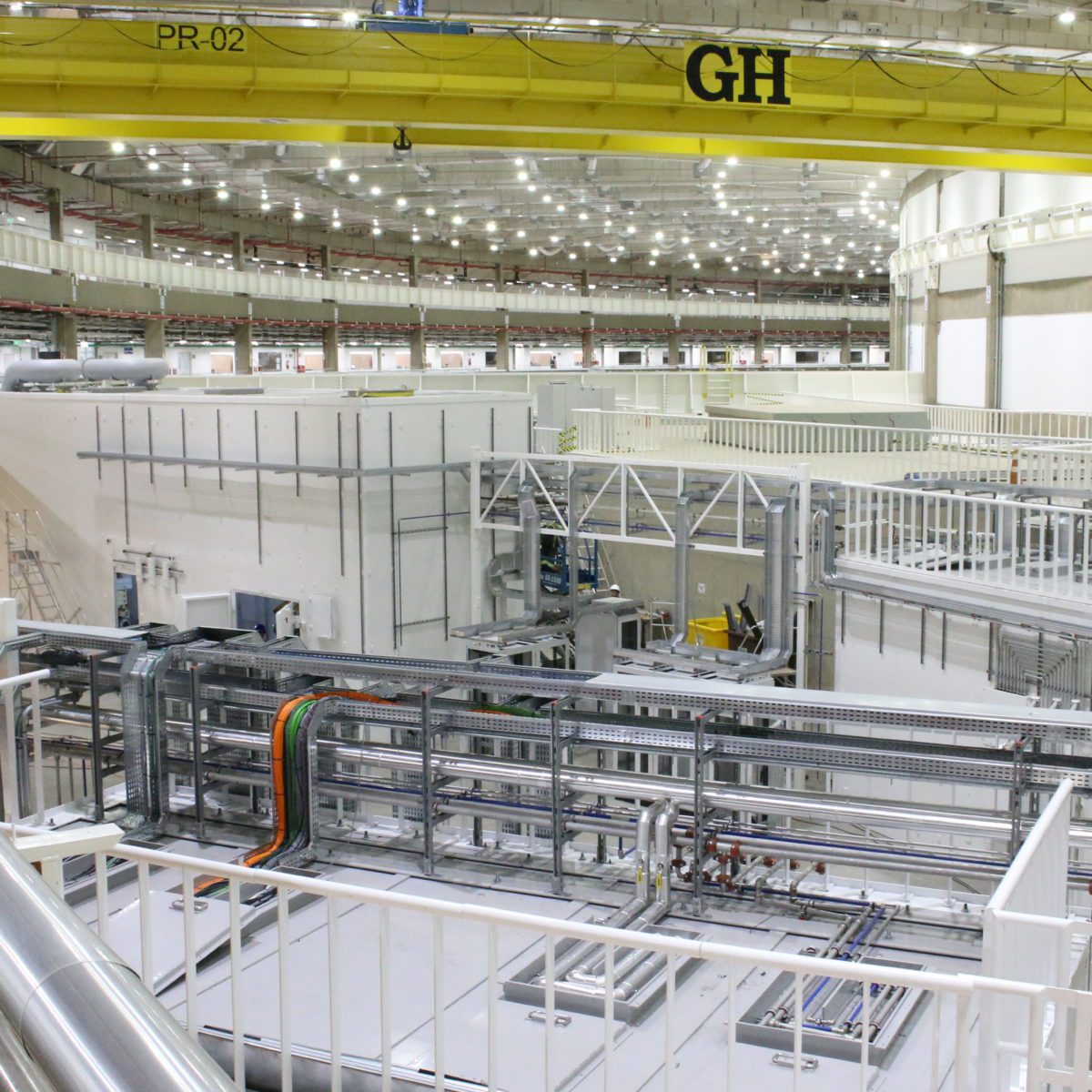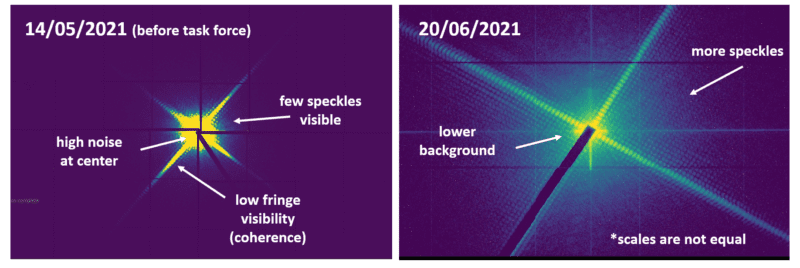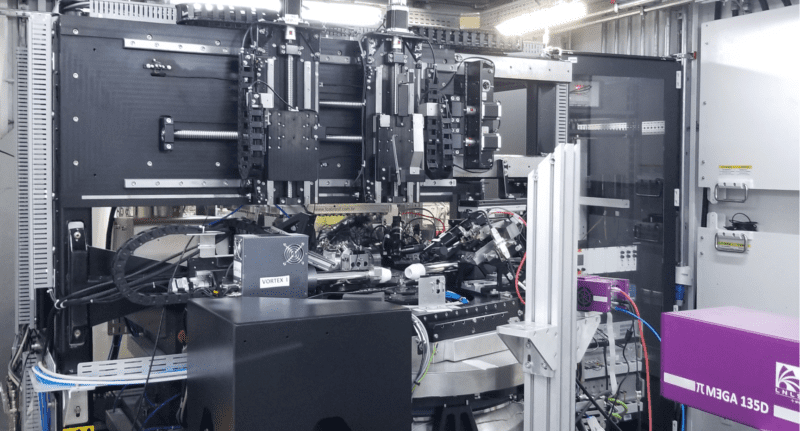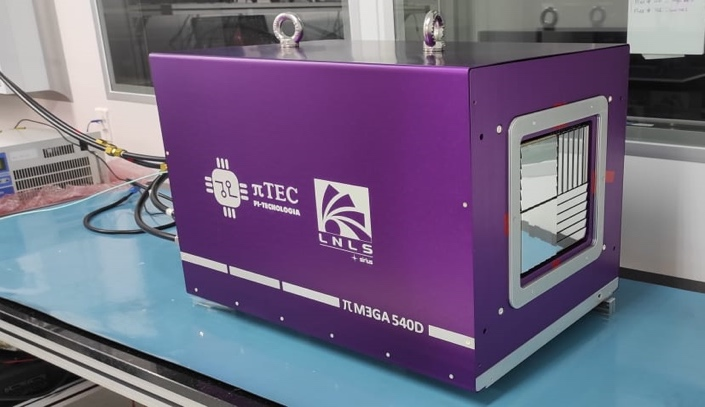
In addition to the MANACÁ beamline, which is already in scientific commissioning, CARNAÚBA and CATERETÊ are also moving from technical to scientific commissioning and should soon receive the first users in this phase
The operation of the synchrotron light source Sirius in the first semester of 2021 divided the human resources and uptime of the accelerators between machine studies, installation of beamline components, and beamtime for technical and scientific commissioning experiments of the beamlines.
The circumstances of the Laboratory’s operation, with the simultaneous commissioning of accelerators and beamlines, are challenging and unusual in third and fourth generation synchrotron light sources, but have generated rich interactions between the teams involved in the Sirius project. After the magnet alignment period in the first two months of the year, which brought the accelerators to conditions closer to the design specifications, the beam time provided for the beamlines grew progressively, maintaining a good compatibility between the programmed time and the delivered time for the experiments.
From April onwards, the beam availability at the scheduled times for experiments on the beamlines was greater than 95%, with a mean time between failures (MTBF) greater than 30 hours and an average time to recovery from failures of less than two hours, which are very satisfactory levels for the current stage of operation.
Since March 2021 the storage ring current has been maintained in injection mode at 70 mA, with two injections per day. This current is about 1/5 of that specified in the project, reducing the photon flux of the experiments in the same proportion. However, for the current phase of the project, neither the current nor the time between injections has been a limiting factor for the beamline commissioning activities. The top-up injection of the electron beam, under development, should further improve the quality of several aspects of beamline operation.
Beamline Commissioning
In the first semester of 2021, installation and commissioning continued for phase 1-A beamlines: CARNAÚBA, CATERETÊ, EMA, IPÊ, MANACÁ and MOGNO. In addition to MANACÁ, which is already in scientific commissioning, CARNAÚBA and CATERETÊ are also moving from technical to scientific commissioning and should soon receive the first commissioning users.
MANACÁ received several research proposals in fast-track access, with 11 external and 3 internal proposals. This resulted in the deposit of 5 more structures in Protein Data Bank (PDB), bringing to 12 the number of protein structures discovered at Sirius since the beginning of the scientific commissioning of MANACÁ.
Developments at MANACÁ continued in parallel with user experiments. During the first semester of 2021, the installation and commissioning of the sample delivery robotic arm took place, and users are already benefiting from this improvement. As a result, in each data collection session, 48 samples can be loaded at a time into the liquid nitrogen dewar, and the entire operation is controlled via the MXCube graphical interface. The main advantage of this system is the speed of data collection, as the user does not need to enter and exit the experimental hutch for each collection. This is also the first step towards implementing fully remote data collection, an option that will be explored in measurements on several of Sirius’ beamlines.
CATERETÊ had all efforts focused this semester on obtaining the first three-dimensional images with nanometer resolution. The results in the first months of measurements in 2021, obtained with tomography of micrometric cubes of zeolites by the plane wave coherent diffraction mode (pwCDI), were very promising. However, the computational reconstruction of the 3D images from the diffraction data obtained in the beamline showed several problems related to different noise sources, from the electron beam to the optical elements of the beamline.

Improvements obtained in the measurements of coherent diffraction after the campaign for optical realignment and reduction of noise sources in the CATERETÊ beamline.
With a detailed review campaign of all subsystems, which consumed practically the rest of the semester, several of the problems were identified and remedied. However, a noise source related to contamination in the monochromator crystal was identified. Although we already have replacement crystals, we chose to bypass the monochromator and continue with the measurements without an interruption that would last for months. With the by-pass in the monochromator, which limits the resolution of the images, it was still possible to obtain images with nanometric resolution through an adaptation of the coherent diffraction measurement method using a pinhole.
The commissioning activities of CARNAÚBA focused on the TARUMÃ nanoprobe experimental station, the first to be commissioned in the beamline. The station has a wide variety of X-ray detectors integrated simultaneously into the X-ray beam scanning imaging experiments.
At the current stage of commissioning, although the beam is still larger than nominally expected, it is already possible to obtain chemical mapping of complex samples. This demonstrates that the beamline is ready to start scientific commissioning with more challenging experiments, allowing us to identify the need for optimization with real user samples.

TARUMÃ station set up for the first experiments in X-ray nanoprobe at CARNAÚBA.
EMA had its first high-pressure diffraction experiments carried out in late 2020 with a provisional experimental setup. Subsequently, during the first semester of 2021, the installation of the definitive setup for high pressures and extreme temperatures was started, which will be completed in the second semester.
The installation of IPÊ’s XPS and RIXS experiments are also close to being completed for commissioning at the beginning of the second semester.
MOGNO’s assembly continued with the completion of the installation of the beamline hutch infrastructure and the assembly of the first hutch’s optics starting in August. The assembly of the KB focusing optical system is scheduled for the second semester.
Beamline Assembly
The first semester of 2021 was marked by the beginning of the construction and installation of beamlines for phase I-B: CEDRO, IMBUIA, JATOBÁ, PAINEIRA, QUATI, SABIÁ, SAPÊ and SAPUCAIA. Of these, IMBUIA, PAINEIRA and SABIÁ have their construction at a more advanced stage.
PAINEIRA’s radiological protection hutches are in the installation phase and the detection systems are in the final phase. Installation of the SABIÁ beamline optical hutch, the only steel hutch needed on this beamline, has also started.
With the partial completion of the IMBUIA installation, the infrastructure is already operational (A/C, gases, lighting, network and power) and the hutches received the microscopes, which will initially operate in offline mode with auxiliary radiation sources. The completion of the installation and synchrotron light extraction will take place when the refrigerated mirror is received.
Beamline Subsystems
During the first semester of 2021, several of the beamline subsystems were commissioned. One of the highlights was the commissioning of the HD-DCM monochromator. Although measurement is still limited by the stability of the electron beam, the results obtained so far indicate a high reproducibility and stability in accordance with the design specification.
Regarding the data acquisition and processing subsystems, the first images of Mobipix detectors with CdTe sensors were obtained. The Si sensors normally used in the X-ray detectors of the beamlines of synchrotron light sources are capable of detecting X-rays up to about 20 keV. Above these energies sensors with heavier chemical elements such as those based on CdTe are needed. These sensors allow high-energy X-ray imaging with high efficiency and will be used at MOGNO.
In addition, the second 10 million pixel piMEGA 540D detector has been received and is being commissioned in the detector laboratory. This detector is identical to the one currently used at CATERETÊ, in vacuum, and will be used in the SAPUCAIA beamline.

Second piMEGA 540D detector delivered by the company piTEC being commissioned in the detectors laboratory.
In the first semester, greater emphasis was placed on improving beam stability, operating at higher currents, as well as optimizing the injector system
LNLS opens a call for proposals in other research areas for macromolecular crystallography experiments